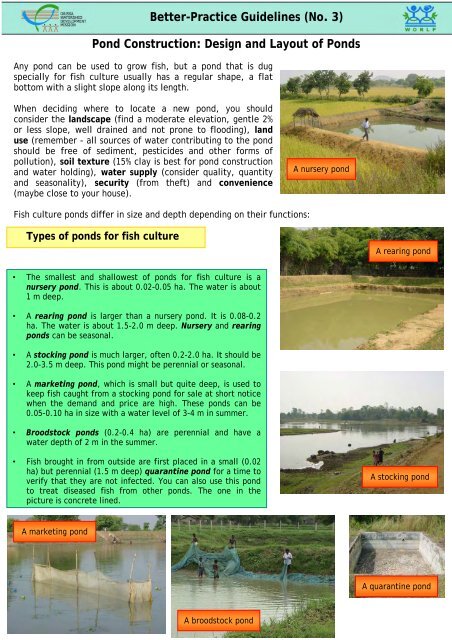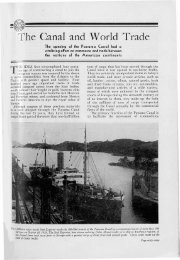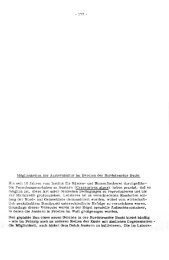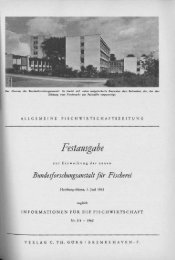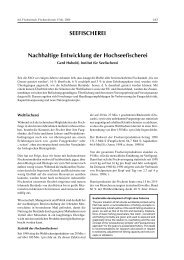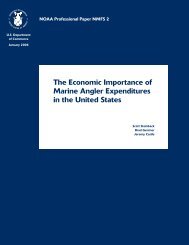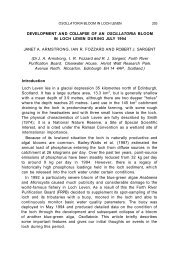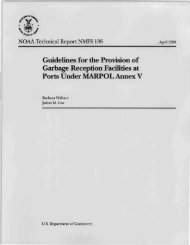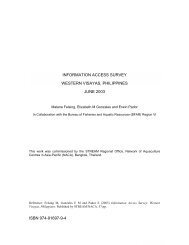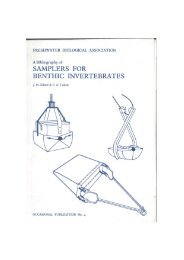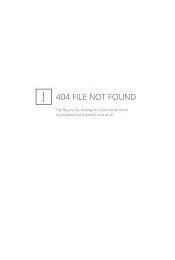Design and Layout of Ponds Better-Practice Guidelines (No. 3)
Design and Layout of Ponds Better-Practice Guidelines (No. 3)
Design and Layout of Ponds Better-Practice Guidelines (No. 3)
Create successful ePaper yourself
Turn your PDF publications into a flip-book with our unique Google optimized e-Paper software.
Pond Construction: <strong>Design</strong> <strong>and</strong> <strong>Layout</strong> <strong>of</strong> <strong>Ponds</strong><br />
Any pond can be used to grow fish, but a pond that is dug<br />
specially for fish culture usually has a regular shape, a flat<br />
bottom with a slight slope along its length.<br />
When deciding where to locate a new pond, you should<br />
consider the l<strong>and</strong>scape (find a moderate elevation, gentle 2%<br />
or less slope, well drained <strong>and</strong> not prone to flooding), l<strong>and</strong><br />
use (remember - all sources <strong>of</strong> water contributing to the pond<br />
should be free <strong>of</strong> sediment, pesticides <strong>and</strong> other forms <strong>of</strong><br />
pollution), soil texture (15% clay is best for pond construction<br />
<strong>and</strong> water holding), water supply (consider quality, quantity<br />
<strong>and</strong> seasonality), security (from theft) <strong>and</strong> convenience<br />
(maybe close to your house).<br />
Fish culture ponds differ in size <strong>and</strong> depth depending on their functions:<br />
Types <strong>of</strong> ponds for fish culture<br />
• The smallest <strong>and</strong> shallowest <strong>of</strong> ponds for fish culture is a<br />
nursery pond. This is about 0.02-0.05 ha. The water is about<br />
1 m deep.<br />
• A rearing pond is larger than a nursery pond. It is 0.08-0.2<br />
ha. The water is about 1.5-2.0 m deep. Nursery <strong>and</strong> rearing<br />
ponds can be seasonal.<br />
• A stocking pond is much larger, <strong>of</strong>ten 0.2-2.0 ha. It should be<br />
2.0-3.5 m deep. This pond might be perennial or seasonal.<br />
• A marketing pond, which is small but quite deep, is used to<br />
keep fish caught from a stocking pond for sale at short notice<br />
when the dem<strong>and</strong> <strong>and</strong> price are high. These ponds can be<br />
0.05-0.10 ha in size with a water level <strong>of</strong> 3-4 m in summer.<br />
• Broodstock ponds (0.2-0.4 ha) are perennial <strong>and</strong> have a<br />
water depth <strong>of</strong> 2 m in the summer.<br />
• Fish brought in from outside are first placed in a small (0.02<br />
ha) but perennial (1.5 m deep) quarantine pond for a time to<br />
verify that they are not infected. You can also use this pond<br />
to treat diseased fish from other ponds. The one in the<br />
picture is concrete lined.<br />
A marketing pond<br />
<strong>Better</strong>-<strong>Practice</strong> <strong>Guidelines</strong> (<strong>No</strong>. 3)<br />
A broodstock pond<br />
A nursery pond<br />
A rearing pond<br />
A stocking pond<br />
A quarantine pond
<strong>Design</strong> <strong>of</strong> ponds<br />
<strong>Ponds</strong> are dug in the ground or formed behind bunds on one, two, three or four sides, which can be<br />
made <strong>of</strong> earth or building materials such as concrete. The diagram below shows an earth bund <strong>and</strong> a<br />
pond as if it has been cut open to show how it is designed.<br />
Spillway<br />
Bund<br />
Collar<br />
The top width <strong>of</strong><br />
the dam should be<br />
at least 1.5 m in the<br />
case <strong>of</strong> nursery <strong>and</strong><br />
rearing ponds, but<br />
not less than 2.5 m<br />
for stocking ponds.<br />
A berm, a sort <strong>of</strong><br />
a step all around<br />
the inner side <strong>of</strong><br />
the bund, slightly<br />
above the water<br />
level helps the<br />
fishermen to move<br />
comfortably while<br />
dragging a net <strong>and</strong><br />
also prevents soil<br />
erosion.<br />
1.5 – 2.5 m<br />
Freeboard<br />
The part <strong>of</strong> the earth<br />
bund where waves<br />
strike should be well<br />
strengthened.<br />
Outlet pipe<br />
3:1 slope<br />
Drain pipe<br />
Core<br />
It is best to<br />
slope the<br />
banks<br />
properly when<br />
building.<br />
Small ponds are easy to manage.<br />
<strong>No</strong>rmally, ponds meant for<br />
aquaculture would be 2.0-3.0 m<br />
deep so the width <strong>of</strong> the<br />
2<br />
bund at<br />
the base would be three times<br />
this.<br />
Level <strong>of</strong> water Embankment<br />
<strong>Layout</strong> <strong>of</strong> ponds<br />
Plug or valve<br />
Make the side slopes <strong>of</strong> earth<br />
bunds stable enough to keep<br />
the earth fill in place <strong>and</strong> stop<br />
them from collapsing. A slope<br />
<strong>of</strong> 3 lengths along the ground<br />
(horizontal) to 1 length<br />
upwards (vertical) (3:1) on<br />
both the upstream <strong>and</strong><br />
downstream faces <strong>of</strong> the dam<br />
will be good.<br />
Square ponds are<br />
cheaper to construct<br />
<strong>and</strong> lose less water,<br />
but rectangular ponds<br />
(width 1 to length 1.5-<br />
2.0) up to 50 m wide<br />
are easier to harvest<br />
with a drag net.<br />
1<br />
3
If the top <strong>of</strong> the dam is 2 m, the<br />
depth 3 m plus 0.5 m freeboard<br />
(3.5 m), the bottom <strong>of</strong> the dam<br />
will be 3 times the depth = about<br />
10 m.<br />
A = ½ (b1 + b2) h<br />
{A=area, b1=top, b2=bottom,<br />
h=depth}<br />
That means the area will be 23<br />
m 2 .<br />
So the earth needed in m 3 will be<br />
the length <strong>of</strong> dam x 21.<br />
To create the bund, you need to add earth in 20-30 cm layers, sprinkle on some water <strong>and</strong> ram<br />
the earth down to make it strong. Finally, put turf on the dam to protect it from the rain.<br />
Yes, nursery ponds<br />
should be near the<br />
home <strong>and</strong> all<br />
valuable fish should<br />
be guarded.<br />
3<br />
The first step is to clean away all<br />
trees, bushes, rocks <strong>and</strong> boulders.<br />
There should be no trace <strong>of</strong> the<br />
roots <strong>of</strong> trees or any vegetation<br />
where the dam will be.<br />
Choosing the place to<br />
dig ponds depends on<br />
the type <strong>of</strong> pond, the<br />
slope <strong>and</strong> water supply,<br />
drainage system <strong>and</strong><br />
roads.<br />
So every 10 meters <strong>of</strong> dam<br />
needs 230 m 3 <strong>of</strong> earth.<br />
20 cm <strong>of</strong> surface soil is scraped<br />
away before building <strong>and</strong> kept<br />
aside <strong>and</strong> spread over the pond<br />
bottom when digging is<br />
complete. In case <strong>of</strong> heavy<br />
seepage, the bottom <strong>of</strong> the pond<br />
should be treated either with a<br />
heavy dose <strong>of</strong> wet cattle dung or<br />
biogas slurry.<br />
Fish ponds need to be<br />
tended <strong>and</strong> kept secure<br />
too.
<strong>Design</strong> <strong>of</strong> the outlet<br />
I am building a MONK – that’s an<br />
outlet so I can slowly reduce the<br />
height <strong>of</strong> water.<br />
Useful Contacts<br />
Other <strong>Better</strong>-<strong>Practice</strong> <strong>Guidelines</strong><br />
There are many more <strong>Better</strong>-<strong>Practice</strong> <strong>Guidelines</strong><br />
in this series.<br />
You can get more copies <strong>of</strong> this <strong>and</strong> other<br />
<strong>Better</strong>-<strong>Practice</strong> <strong>Guidelines</strong> from your local Onestop<br />
Aqua Shop, STREAM India Communications<br />
Hub, from the STREAM Regional Office or from<br />
the STREAM Website.<br />
www.streaminitiative.org<br />
We would like your feedback about these <strong>Better</strong>-<br />
<strong>Practice</strong> <strong>Guidelines</strong>. You can let us know by<br />
phoning, emailing or writing to the<br />
Communications Hub Manager at your STREAM<br />
Country Office.<br />
These are<br />
wooden boards –<br />
with clay to<br />
make them<br />
water tight.<br />
This U-shaped<br />
part is made <strong>of</strong><br />
concrete.<br />
This is where the<br />
water goes.<br />
Your local One-stop Aqua Shop is:<br />
Out-flow<br />
The STREAM India Communications Hub is:<br />
STREAM Country Office India<br />
Duplex <strong>No</strong>.02, T.S. Homes,<br />
Tankapani Road, Bhubaneswar - 18<br />
Phone: +91-674-2381851<br />
Phone:<br />
Fax: +91-674-2381851<br />
Fax:<br />
E-mail: streamin@sancharnet.in<br />
Email:<br />
The WORLP Office is:


